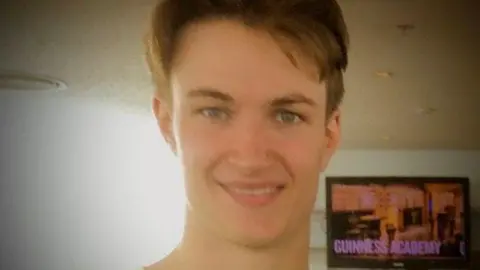Swimmer underwater for five minutes before rescue attempted
 Teresa and Malachy Rogers
Teresa and Malachy RogersThe trial of three lifeguards over the death of a swimmer has heard that Christopher Rogers was at the bottom of a pool for five minutes before a rescue was attempted.
Mr Rogers, who was 20, died during a swim session at the Orchard Leisure Centre in Armagh in April 2017.
Cathal Peter Forrest McVeigh, 35, of Dunamony Road in Dungannon, James Monaghan, 26, of Folly Lane in Armagh and William Holden, 26, of Unshinagh Lane in Portadown were on duty the night Mr Rogers died.
The charge against them stated that "being an employee, [they] failed to take reasonable care for the health and safety of other persons who may be affected by [their] acts or omissions at work".
All three men have pleaded not guilty.
Newry Crown Court heard that on the day of his death Mr Rogers, who was an experienced swimmer, had been swimming underwater for about a minute before breaking the water's surface.
He then descended to the bottom of the pool and lay there for five minutes and 14 seconds before a rescue attempt was initiated.
He was later pronounced dead.
A coroner said he had lost consciousness due to a lack of oxygen.
CCTV footage
On Thursday, the court was shown four views of CCTV footage of the incident. It showed the movements of Mr Rogers and the lifeguards.
The prosecution argued the men did not do their jobs properly because of the length of time it took before the rescue attempt began and other omissions in their roles.
Prosecution lawyer Liam McCollum said that while five minutes may not seem like a long time for some things like waiting for a bus, "for someone to be at the bottom of a pool, not emerging - five minutes and 14 seconds is a very, very long time".
'They did not do this job properly'
Turning to what the three defendants were doing at the time of the incident, he told the jury that Mr Holden was in the lifeguard chair, while Mr McVeigh and Mr Monaghan were pool side and were "in conversation at the corner of the deep end".
"During that conversation, Mr Rogers breaks the surface and then submerges to the bottom of the pool having suffered a hypoxic blackout," Mr McCollum said.
The lawyer said that over the course of the next three minutes, Mr Monaghan is in and out, but is beside Mr McVeigh when he uses a metal pole to strike the steps "to try to get a response from Mr Rogers".
"There appears to be no response" the jury were told.
A minute after that, Mr McCollum said that Mr McVeigh can be seen signalling to another swimmer to check on Mr Rogers and the jury heard the victim "gave him a thumbs up".
He said that one minute after that, Mr McVeigh signals to Mr Holden in the chair who then goes to get a radio and a few seconds after that, two members of the public "duck under" and retrieve Mr Rogers from the bottom of the pool.
Mr McCollum told the court that each of the defendants failed in their duty as lifeguards and he highlighted extracts from the lifeguard handbook which stipulated several measures which he suggested were "just common sense".
"Their job was to guard lives…their job was to be vigilant for the safety of everybody who was swimming in the pool and if anyone look to be in any trouble, to save them," said Mr McCollum.
"The prosecution say that self-evidently, they did not do this job properly because a very long period of time passed between Mr Rogers hitting the bottom of the pool and any rescue attempt."
Earlier, a witness to the incident, Dr Mark Haynes also told the court he had been at the pool volunteering for his children's swimming club.
He said that he had noted Christopher Rogers was doing some breath-holding exercises underwater, when he had remained stationary.
"I recall someone swimming down and then suggesting that Christopher had given him the thumbs up."
 Teresa and Malachy Rogers
Teresa and Malachy RogersThe Police Service of Northern Ireland (PSNI) told BBC News NI that Christophe Roger's death was deemed non-suspicious immediately after the incident in April 2017.
The force said it carried out enquiries, including recording statements, on behalf of the coroner.
In January 2018, the incident was referred back to police by the Health and Safety Executive (HSE), which believed there was potential for criminal offences. The investigation was taken forward on a joint basis.
The trial is expected to last up to two weeks and will hear evidence from more than 30 witnesses.
The trial is set to continue on Friday.
